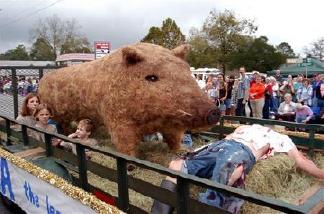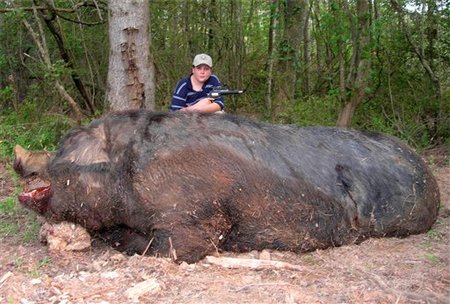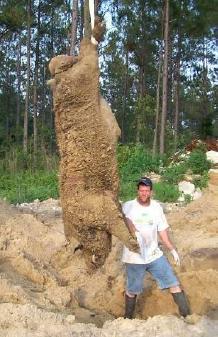Claim: Photograph shows a 12-foot-long, 1000-lb. hog dubbed 'Hogzilla.'
Status: Multiple — see below.
Example: [Collected on the Internet, 2004]
Origins: The "Hogzilla"
photo that took the Internet by storm in the last week of July 2004 is an oddity in the world of online rumor, in that the presenting tale and its accompanying snapshot of a giant hog strung over a pit went unnoticed until the media popularized it. Prior to its appearance on the web sites of CNN, Fox News, MSNBC and Yahoo! News, the Associated Press article casting doubt on the veracity of a giant hog's being shot on a Georgia plantation had not circulated in cyberspace.
Datelined Alapaha, Georgia, the 28 July 2004 Associated Press article advised readers to remain somewhat skeptical of the tale because its writer had been unable to verify the size or weight of the hog, or indeed any of the other details given in the account. Only
 |
| Hogzilla Float, Nov. 2004 |
two people supposedly saw the beast: its slayer, and the owner of the property where it was downed. Chris Griffin, the hog's slayer, said he and Ken Holyoak, the owner of the River Oak Plantation, buried Hogzilla on the property. The photograph was taken sometime in June 2004 near Alapaha, a town with a population of 682.
Holyoak claimed that because he couldn't fit the huge animal in his freezer intact, and its meat was not suitable for eating, he and his crew decided to bury it instead. He maintained they cut off the head (described by Holyoak as "about as big as a car tire") and interred it separately from the rest of the hog's remains in an undisclosed location because they were feared someone would try to steal it. Nonetheless, there was reason to doubt the claim of the hog's weighing a thousand pounds — not only aren't feral hogs known to grow to that size, but one has to wonder how the killer of this particular ground-rooter came by the "1000 lbs." figure. It's not as if folks routinely port about scales capable of weighing something that large, and according to the AP account, the hog was never dragged to any location where it could have been weighed.
Farm-raised hogs, however, have been known to grow to sizes even larger than that claimed of Hogzilla:
A hog that size would probably be 5 years old, he said. The animals will grow tusks in the wild. Domesticated, their tusks are trimmed because they are dangerous.
Darrell Anderson, CEO of the Lafayette, Ind.-based National Swine Registry, said farm-raised hogs grow as large as 1,300 pounds and measure as long as 7 feet along the backbone from head to tail. "If you hang them by their hind legs and you have the front legs stretching out, you'll get another four or five feet," he said.
Although the photograph is real, it contains clues to a bit of exaggeration in the telling of this tale: the man pictured beside the strung-up hog is standing in an area that has been dug up. Once one accounts for the remainder of the man's legs (which are hidden from view in the pit) and
mentally compares the complete figure with the suspended hog, the claim of the beast's being "nearly twice as long as the 6-foot-tall Griffin" collapses, because the human figure comes up only a bit shorter than that of the felled animal.
<!--
Likewise, a mental comparison of the supposed "9-inch tusks" to the man's hand shows them to span the same distance as the tips of his fingers to their base, a distance of about 3 to 4 inches on a typical fellow. Even if one judges the span to terminate in the mid-palm region, that would still make the tusks far shorter than reported, in that such span is typically 4 to 5 inches on an adult man.
-->
Also, items placed in the foreground of photos tend to look larger than they are, and in this picture the man is standing to the rear of the hog. The beast, therefore, looks bigger in comparison to the man than it would if the two had been snapped side by side. Indeed, when the National Geographic Society sent a team of scientists to exhume Hogzilla, what they found was not a 12-foot behemoth of a hog, but an animal they estimated had measured about 7-1/2 feet in length and weighed around 800 lbs. — a hybrid of wild boar and domestic Hampshire pig that the Atlanta Journal-Constitution described as "large, perhaps even record-setting large, but not hide-the-children-and-get-your-guns large."
May 2007 brought both the announcement that an independent filmmaker was planning to produce a horror movie about the monster porker (to be entitled The Legend of Hogzilla) and the claim that an 11-year-old Alabama boy had killed a hog even bigger than the renowned super swine:

According to various news reports, on 3 May 2007 near Delta, Alabama, 11-year-old Jamison Stone used a pistol to shoot and kill a wild hog weighing a staggering 1,051 pounds and measuring an incredible 9-feet-4 from the tip of its snout to the base of its tail — measurements which, if documented, would make the creature considerably larger than Hogzilla. Since then, much debate has raged about whether the photographs of the monster pig were genuine, whether the creature was really as big as claimed, and whether the animal was truly feral rather than a domesticated hog that had been raised as a pet and had only recently been released into a hunting preserve (where Jamison shot it).
At the MonsterPig web site wet up to publicize Jamison's feat, the boy's father now says:
The news media used [the pig] for headlines for a week, claiming its size was a hoax. On the evening of May 31, I was contacted by Bran Strickland of the Anniston Star and he told me that he had good news and bad news. He said that the good news is your claims about the pig's massive size have been verified. The bad news is that he came from a hog breeder and that the pig had been sold from the breeder to the preserve for the purpose of hunting. Early on the morning of June 1, I went to the computer and read Bran's article which portrayed the pig as a family pet. The pig that Jamison killed did not act like a family pet. It was a very aggressive animal. I was upset at first to read this report but after going through a week of being told what we killed did not exist by the network media, I decided to get to the bottom of this myself. I got my whole family up at 6:00 a.m. and traveled to Heflin, AL to meet with the Blissitts to give Phil Blissitt, whom I have never met or talked to before, the opportunity to explain to Jamison why he had sold a pig that was described as being so gentle and sweet to a hunting preserve in order for someone to come and kill it.
Barbara "hog wild" Mikkelson
Last updated: 2 June 2007
 Sources:
Sources:

